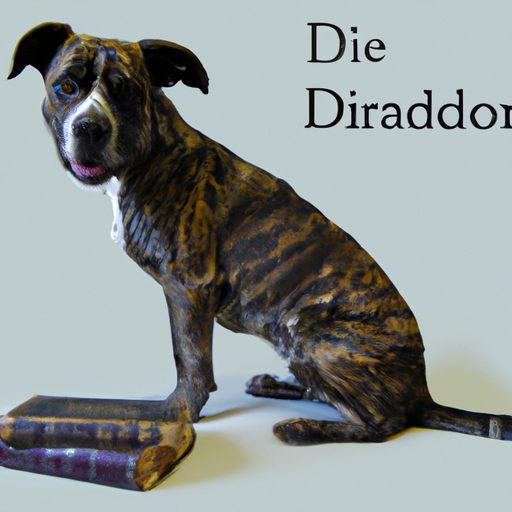When you’re choosing a new canine companion, one of the first things you might notice is their coat color and pattern. Of the many patterns available, the brindle is among the most unique and striking. But what does brindle mean in dogs?
Table of Contents
- Understanding the Brindle Pattern
- Genetics Behind the Brindle Pattern
- Breeds That Can Have the Brindle Pattern
- Caring for Brindle Dogs
- Frequently Asked Questions
Key Takeaways
- The brindle pattern in dogs refers to a coat pattern characterized by a mixture of black and lighter colored hairs.
- Brindle is a dominant gene and can appear in any breed, although it is most common in certain breeds like Boxers, Bulldogs, and Mastiffs.
- Caring for brindle dogs does not differ significantly from caring for dogs with other coat patterns.
Understanding the Brindle Pattern
The term ‘brindle’ refers to a coat pattern that features a mixture of dark and light strands, often in a striped or ‘tiger-stripe’ pattern. The effect is often visually striking and can range from subtle to bold.
The brindle pattern is not a color, but a pattern. The color of the dog’s coat can vary widely, from a light cream or fawn color to a deep, rich red or chocolate. The darker strands can be black, brown, or even blue or grey, depending on the breed.
The brindle pattern can appear all over the dog’s body or be confined to certain areas. For example, some dogs may have brindle patches on their chest, legs, or tail. It’s also possible for a dog to be ‘reverse brindle’, where the darker color is more dominant and the lighter stripes are less pronounced. This can give the dog’s coat a more solid appearance.
Genetics Behind the Brindle Pattern
The brindle pattern is caused by a specific gene, known as the K locus. This gene is dominant, which means that a dog only needs to inherit one copy of the gene from their parents to show the pattern in their coat. This also means that a dog can pass on the brindle pattern to their puppies, even if they are bred with a dog that does not have the brindle pattern.
Interestingly, the brindle pattern is not tied to a specific breed. It can appear in any breed, as long as the dog carries the brindle gene. However, the pattern is most commonly seen in certain breeds, such as Boxers, Bulldogs, and Mastiffs.
Breeds That Can Have the Brindle Pattern
While the brindle pattern can appear in any breed, it is particularly common in several breeds. Some of these include:
- Boxer: The brindle pattern is common in Boxers, often paired with white markings. They can have either a standard brindle pattern or a reverse brindle pattern.
- Bulldog: Both English and French Bulldogs can have the brindle pattern. The pattern can range from light to dark and can be paired with other patterns, like piebald or white markings.
- Mastiff: The Mastiff breed includes several individual breeds, many of which can have the brindle pattern. This includes the English Mastiff, Bullmastiff, and Neapolitan Mastiff.
For a more extensive list of breeds with the potential for a brindle coat, I recommend checking out this resource.
Caring for Brindle Dogs
Despite their unique and striking coat pattern, brindle dogs do not require any special care compared to dogs with other coat patterns. Their grooming needs will depend more on their breed and coat type than on their color pattern.
However, like all dogs, brindle dogs can benefit from regular grooming to keep their coat healthy and shiny. This may include regular brushing to remove loose hairs and distribute natural oils, as well as regular baths to keep their coat clean.
When it comes to health concerns, brindle dogs do not have any specific health issues linked to their coat pattern. However, each breed has its own set of potential health concerns, so it’s always a good idea to research your dog’s breed and be aware of any potential breed-specific health issues.
For more specific tips on caring for brindle dogs, you might find this article helpful. It provides valuable advice based on the specific breed of the brindle dog.
Frequently Asked Questions
-
Is the brindle pattern rare?
The rarity of the brindle pattern can vary greatly depending on the breed. In some breeds, like Boxers and Bulldogs, the brindle pattern is quite common. In others, it may be more rare. -
Can any breed of dog have a brindle pattern?
Technically, the brindle pattern can appear in any breed. However, it is more common in certain breeds due to selective breeding. -
Does the brindle pattern affect a dog’s behavior or personality?
No, a dog’s coat color or pattern does not affect its personality or behavior. -
Are brindle dogs more expensive?
The price of a dog can vary based on a variety of factors, including breed, pedigree, and coat color or pattern. However, the brindle pattern itself does not typically make a dog more expensive.
Conclusion
The brindle pattern in dogs is a unique and striking coat pattern that sets certain dogs apart. Whether you’re a fan of the bold, tiger-stripe look, or the more subtle, reverse brindle pattern, there’s no denying the beauty of these dogs. Remember, the brindle pattern does not affect a dog’s personality or behavior, so don’t let it be the sole factor in choosing your next canine companion. Instead, consider it another beautiful aspect of your dog’s unique individuality.
For more insights into dog breeds and their unique characteristics, feel free to browse other resources on our site. For information on specific brindle breeds, you might find these articles on Boxers, Bulldogs, and Mastiffs quite enlightening.



